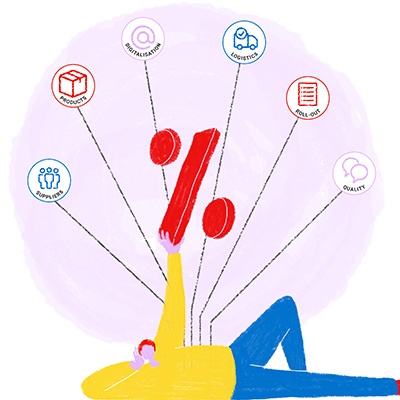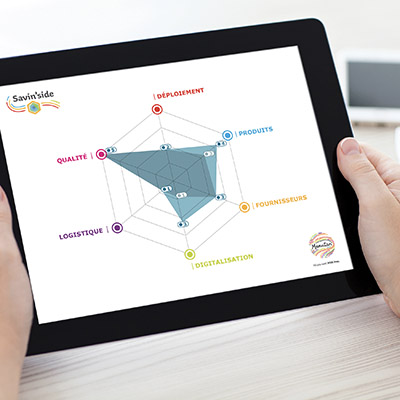To gain a competitive edge, organisations are striving to reduce their environmental impact whilst boosting their economic performance. This requires access to reliable and transparent data to make informed decisions. Life cycle assessment (LCA) has emerged as an essential tool for evaluating the products’ environmental impact and services throughout their entire life cycle. Today, many companies have grasped the importance of understanding the environmental impacts of the products and/or services they manufacture, as well as those they purchase, throughout their entire supply chain.
What is life cycle assessment (LCA)?
Life cycle assessment is an evaluation method that aims to quantify the environmental impacts of a product, service or process, taking into account all stages of its life cycle. This allows each company to obtain a holistic view, going well beyond the carbon footprint.
Dr Rukayya Ibrahim Muazu, LCA expert at the Grantham Centre for Sustainable Futures, adds: "LCA is the most recognised tool for assessing the potential environmental impacts of products or processes. One of LCA’s strengths is its ability to consider multiple substances and processes. Another strength is that LCA is flexible and can be performed even before the product is manufactured. However, some aspects of the process may only be revealed once production has begun. In this case, it may be necessary to update the LCA along the way, which is possible."
Life cycle assessment (LCA) has thus established itself as the reference method for evaluating impacts on the environment, as it combines a dual "life cycle" and "multi-criteria" approach. Moreover, it is now standardised globally through the international ISO 14040 and 14044 standards for environmental management.
The "life cycle" approach
Firstly, conducting a life cycle assessment involves creating an inventory of all material and energy flows associated with an activity, reviewing all phases of the product life cycle.
This includes three main stages:
- The product’s birth or creation: Extraction, transformation and supply of raw materials, then manufacturing, assembly and packaging, distribution and marketing of the product;
- The product’s life: Transport, unpacking, use, maintenance…;
- The product’s end of life: Collection, transport, recycling, waste treatment…
The "multi-criteria" approach
LCA also entails analysing all inputs and outputs. This analysis includes everything involved in the manufacturing process, as well as everything resulting from this process, in terms of impacts of various natures. On the input side, we find water, energy and raw material resources. On the output side, there are greenhouse gas emissions, liquid discharges…
The objective is to account for them, then associate them with environmental impact indicators (climate change, acidification, eutrophication, depletion of natural resources…).
The various phases of life cycle assessment
The LCA methodology is organised into four phases, from defining the study framework to interpreting the results.
Defining the goal and scope of the study
This first step involves defining the objective, target, functional unit and boundaries of the system to be analysed.
Life cycle inventory
Next comes data collection. This involves quantifying all inputs and outputs across all the life cycle stages. This data is related to the functional unit that was previously determined.
Life cycle impact assessment (LCIA)
The collected data is then converted into potential impacts on the environment, generally using software. There are two categories of impacts: Midpoints and endpoints, which are respectively in the middle and at the end of the causal chain.
Interpretation of results
This final step consists of validating that the results obtained actually meet the initially set objectives. This generally allows for identifying areas for improvement and making decisions in favour of sustainable development.
LCA: What application in business?
Life cycle assessments are formidable decision-making and strategic tools. Companies use them primarily in an eco-design approach. This allows the companies to systematically integrate ecological issues into the development of their activities. The objective: To reduce negative impacts on the environment as much as possible, for an equivalent or even superior service rendered. The challenge is to achieve a balance between technical, economic, environmental and social requirements.
After improving the environmental performance of their products and/or services, companies have every interest in communicating these results to their customers. It is important to highlight their environmental and technical added value in the market. Some players even go so far as to develop their own environmental impact score based on this methodology.
Any company is then able to identify the environmental issues surrounding its activities, make a relevant comparison between products and, finally, implement communication through precise arguments. LCA thus represents a formidable means of anticipating future regulations, strengthening competitiveness and boosting turnover.
Life cycle assessment, supporting procurement
For the procurement function, LCA is a key lever for promoting the selection of products with low impact on the environment and thus strengthening their sustainable procurement policy. Several ways of operating are also at their disposal.
Adjusting supplier sourcing
Firstly, procurement departments can require their suppliers to share information about their products and/or services’ environmental footprint. This can even be integrated into contractual clauses. Thanks to LCA, buyers can then compare their suppliers, but above all the products and services they purchase from them, in light of environmental criteria.
Optimising product selection
Next, procurement departments can work with these same suppliers to optimise their product selection. This involves analysing their product consumption, then substituting part of it with references that have a lower environmental impact, presenting equivalent functionalities.
Raising awareness among internal stakeholders
Lastly, it is important to raise awareness among internal customers about the sustainable procurement policy, especially when it comes to indirect procurement. In this sense, it may be interesting to highlight the environmental performance of products on electronic catalogues (Punch-Out).
Whether it’s contractual mentions, optimisation projects or internal communication, these are all levers that allow consumption to be oriented towards a more environmentally friendly offer, relying on LCA.
As you can understand, life cycle assessments (LCAs) offer companies a systemic and holistic approach to evaluate the environmental performance of their products and services. By mastering this fundamental notion, they are then able to reduce the environmental footprint of their procurement strategy, supporting sustainable development.





_1110x555.jpeg)



